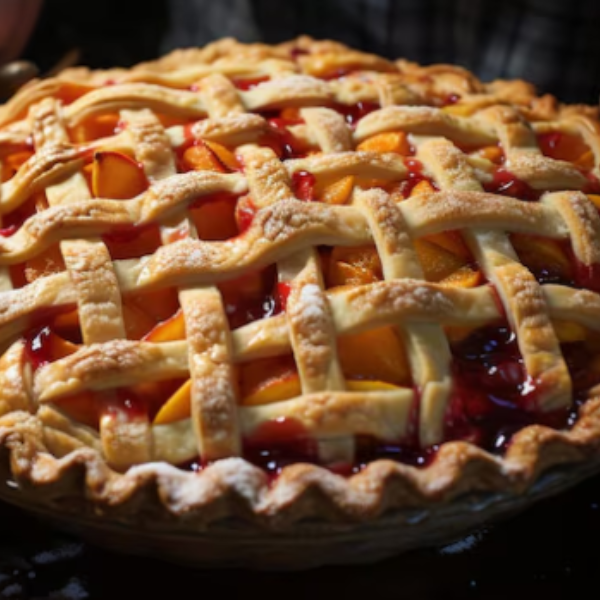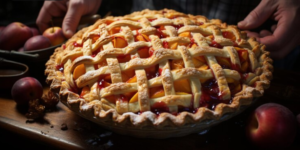What is a cobbler pie? Often just called « cobbler, » is a cherished American dessert known for its simplicity and comforting taste. It features a layer of fruit filling under a biscuit or dumpling topping. Originating from the British American colonies, settlers created cobblers as a practical adaptation of traditional suet puddings. The term « cobbler » likely comes from the rough, cobbled-together appearance of the dough topping, resembling cobblestone streets.
Cobblers can include various fruits like peaches, berries, apples, or cherries, depending on regional tastes and seasonal availability. Sugar and a thickening agent such as flour or cornstarch are also typically added to the fruit mixture. This section will cover the evolution of cobbler pie from a colonial necessity to a beloved component of American culinary tradition, examining its basic ingredients and their combination into a beloved treat.
Ingredients and Varieties
Cobbler pies are beloved for their simplicity and the hearty, comforting texture they offer. The basic ingredients include:
- Fruit: The star of the cobbler, choices vary from peaches, blueberries, blackberries, strawberries, apples, and cherries. The fruit can be fresh, canned, or frozen, depending on availability and season.
- Sweeteners: Sugar, commonly brown or white, is used to sweeten the filling. Honey or maple syrup can be alternatives for a more nuanced flavor.
- Thickeners: Flour or cornstarch is mixed with the fruit to help thicken the juices released during cooking.
- Dough Ingredients: This includes all-purpose flour, baking powder, and salt for the topping. Some recipes call for a leavening agent to make the topping fluffier.
- Fat: Butter is the most commonly used fat, providing moisture and flavor to the dough. Some variations use shortening or lard.
- Liquids: Milk or buttermilk is added to the dough to achieve the desired consistency. Sometimes, the juice from the fruit itself is sufficient.
- Spices and Flavorings: Cinnamon, nutmeg, vanilla extract, and lemon zest are popular choices to enhance the flavors.
These ingredients are mixed and matched based on personal preference and the type of cobbler being prepared, allowing for a versatile dessert experience.
Popular Varieties of Cobbler Pies
Cobblers vary significantly across different regions, each adopting unique twists that reflect local tastes and available ingredients:
- Peach Cobbler: Perhaps the most famous variety, especially popular in the Southern United States. It is often served with vanilla ice cream or whipped cream.
- Berry Cobbler: Uses a mix of berries like blueberries, raspberries, and blackberries. Popular in regions where berries are abundant.
- Apple Cobbler: A fall favorite in many parts of the U.S., often spiced with cinnamon and nutmeg to complement the apples.
- Cherry Cobbler: Known for its vibrant color and tart flavor, cherry cobbler is a delightful treat, especially during the cherry season.
- Savory Cobblers: Though less common, savory versions exist, using less sugar and incorporating ingredients like tomatoes or meat, resembling more of a deep-dish pie.
Each variety of cobbler pie offers a unique taste experience, making cobblers a versatile dish that can cater to different palates and preferences, solidifying its status as a beloved dessert across America.
Frequently Asked Questions
This section addresses some of the most common questions about cobbler pies, providing insights and answers based on popular queries from the « People Also Ask » section:
- What is the difference between a cobbler and a pie?
- Cobblers are made with a fruit filling topped with a biscuit, dumpling, or batter topping, which is baked. In contrast, pies generally have a pastry base and top.
- Can I use canned fruit for making cobbler?
- Yes, canned fruit can be used, especially out of season. However, fresh fruit is preferred for the best flavor and texture.
- What are some tips for making the perfect cobbler crust?
- Keep your butter cold for a flaky topping, don’t overmix the dough, and make sure to spread the topping evenly for consistent cooking.
- How can I make my cobbler healthier?
- Reduce the amount of sugar, use whole grain flours for the topping, and consider adding less butter or substituting part of it with applesauce.
- Is cobbler supposed to be gooey or crispy?
- This depends on personal preference and the specific recipe. Typically, the fruit layer is gooey and syrupy, while the topping should be crisp and golden.
- Can cobbler be made gluten-free?
- Yes, you can substitute regular flour with gluten-free alternatives such as almond flour or a gluten-free baking mix.
- What are the best fruits to use in a cobbler?
- Peaches, blackberries, blueberries, and apples are popular choices. The key is to use ripe, seasonal fruits for natural sweetness and robust flavors.



